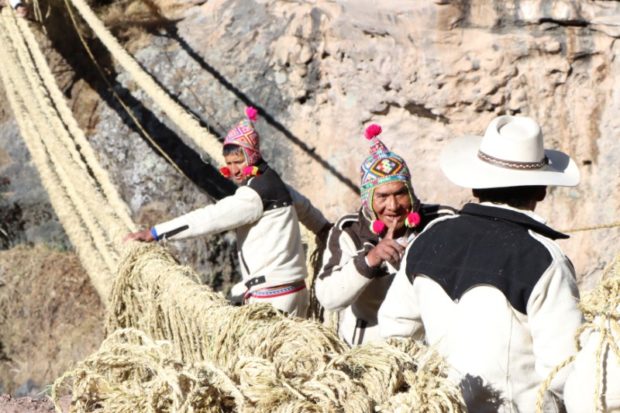Peruvians re-weave Incan string bridge frayed in pandemic

Members of the Huinchiri community rebuild an Incan hanging bridge, known as the Qeswachaka bridge, using traditional weaving techniques in Canas, Peru, June 13, 2021. Picture taken June 13, 2021. REUTERS
LIMA — Peruvians from the Huinchiri community in Cusco region are rebuilding a 500-year-old Incan hanging bridge, made using traditional weaving techniques to literally string a crossing together spanning the Apurimac river far below.
The Q’eswachaka bridge has been used for over 500 years to connect communities divided by the river. But during the COVID-19 pandemic it fell into disrepair and collapsed in March.
Members of the affected communities, such as the Huinchiri, decided to rebuild the 30-meter (98.43 ft) long bridge in the traditional Incan style: by weaving it.
Teams of workers, starting from both sides of the ravine and balancing on giant main ropes that had been stretched over the river, worked towards the center putting in place smaller ropes as barriers between the handrail ropes and the walkway’s floor.
“Last year because of the pandemic, it wasn’t strengthened … That is why at the beginning of this year the bridge fell,” said Cusco Regional Governor Jean Paul Benavente.
“But now it is like an answer to the pandemic itself. From the depths of the Peruvian Andean identity, this bridge is strung up across the Apurimac basin and we can tell the world that we are coming out if this little by little.”
In 2013, UNESCO recognized the skills and traditions associated to the reconstruction of the Q’eswachaka bridge as Intangible Cultural Heritage of Humanity.
Peru is rich in ancient treasure. It has hundreds of sites that date back thousands of years and span dozens of cultures, including the ancient Incan empire that was in power when Spanish explorers arrived in the early 1500s.
“This is history. More than 500 years of a paradox in time. The Q’eswachaka, this Incan living bridge, is really an expression and cultural manifestation,” added Benavente.
“This is community, in this particular case, the Huinchiri community from the Quehue district is currently working to string up this bridge that connects villages, but that also connects traditions and connects culture.”